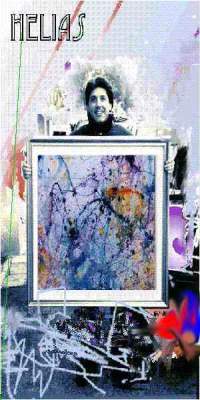|
Gallery
& exhibition
Critics
Studio 1
Studio
2
In Working
Thinking
Art
Work
Art Work1
Art
Work2
Sculpture
design
Scuplture
2006
Sculpture
2007-1
Sculpture
2007-2
Sculpture
2008
Art
Work:
by Annabell
by
The Light of Africa
by
The Light of Africa A
by
TLAfrica-Festadei Popoli
Friend
Art Stefano
Friend
Art Daniele
Friend
Art Hermann
Friend
Art Bertoli G.
Friend
Art Rok e Alessio
Friend
Art Muzic Ivan
Friend
Art Alessandro
|
|
 Noi
possiamo andare oltre lo specchio... per leggere il contenuto della nostra
ANIMA... che è "nei miei Universi" la stessa per tutti noi. Noi
possiamo andare oltre lo specchio... per leggere il contenuto della nostra
ANIMA... che è "nei miei Universi" la stessa per tutti noi.
We can go beyond the mirror... to read the contents of our SOUL... SHE is
"in my Universes" the same for us all.
Renato Elia - Helias das Licht
Our artist Renato Elia is an Italian painter, born in the summer of 1949 in the city of Udine in the northern part of Italy.
Renato Elia holds a diploma in Industrial Electronics. He took several jobs and assumed active responsibilities in this field of specialization in Italy and some other European countries. This allowed him to enlarge his scope of studies to include Therapeutic studies at Berne and Neuro-Phsyco Language.
Renato Elia was born with the art of painting and it grew with him all the way through and so did his creativity. He started his paintings at an early stage of his childhood, and at maturity, he emerged into his universes bringing the earth and the properties of Mother Nature into co-existence.
His paintings contributed ito curing persons with special needs as well as individuals suffering instabilities. A look at his paintings gives us a feeling of a better future.
His project is "The Children of the Future" and the project of his works is for the future. Renato Elia always wonders '' Will there be children 5000 years from now?''.
Renato Elia leans back in his chair and says: ‘’Yes, and we will meet them in the universes of the paintings.
At present, Renato Elia resides at Via Duse 22, Gorizia, northeast Italy.
renato
elia c. v.

I ricercatori: l'arte è un antidolorifico
da La Stampa WeB - 18/09/2008 BARI
Una tela di Botticelli tre volte al giorno o il bacio di Gustav Klimt somministrato per un paio d’ore al dì. La ricetta del medico potrebbe presto subire una piccola grande rivoluzione, con l’arte che guadagna terreno rubando spazio ad antinfiammatori e pillole contro il dolore. Il nuovo e insolito antidoto alla sofferenza, per il momento testato solo su acciacchi e dolori fisici e non come rimedio alle pene d’amore, arriva da uno studio italiano che ha guadagnato le pagine della celebre rivista ’New Scientist’. Prove scientifiche alla mano, il team di ricercatori dell’università di Bari guidato da Marina de Tommaso ha dimostrato che l’arte, oltre ad allietare lo spirito, è in grado di ridurre il dolore fisico. La ricerca tricolore, suggerisce un articolo apparso sul Daily Mail, potrebbe presto lasciare un segno in ambulatori e studi medici, dove riproduzioni di celeberrime e amate tele, dal Caravaggio a Picasso passando per Hayez e Modigliani, potrebbero far capolino sui muri per distrarre i pazienti che hanno subìto piccoli interventi o iniezioni dolorose. Nonché far sì che, per i pazienti in convalescenza, le cure prevedano anche una capatina nel museo o la galleria d’arte più vicina. Lo studio è stato condotto su un campione di 12 persone di ambo i sessi, invitate a scegliere e selezionare le 20 immagini considerate più belle e altrettante ritenute brutte in una galleria di 300 immagini. Tra queste non poteva certo mancare la nascita di Venere del Botticelli, tra le figure più gettonate dai volontari. A questo punto il campione doveva osservare, alternativamente, alcune delle immagini ritenute più belle, altre considerate maggiormente brutte e una tela vuota, mentre con un laser i ricercatori inviavano un breve impulso doloroso sulle loro mani. Il laser, precisa l’articolo apparso sul New Scientist, è stato progettato per produrre effetti spiacevoli, ma senza provocare, chiaramente, alcun danno fisico.
|